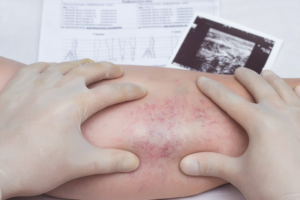 If you suspect you may have vein issues seeking medical attention as soon as possible is the best way to get your legs back to health.
If you suspect you may have vein issues seeking medical attention as soon as possible is the best way to get your legs back to health.
Surface level veins are pretty easily diagnosed visually but when vein issues are deeper there are certain medical tests and procedures that can be processed when it comes to finding the damage and determining the extent. These same tests can also be used to rule out possible conditions.
If your skin in the area affected is having issues as well it is not unusual for your Dermatologist to work in conjunction with your Vein Specialist.
The Exam
Both standing and seated a visual examination is done on the patients’ legs. Questions will be asked as to how you feel standing, walking, sitting, running, and even while sleeping.
Ultrasound (Duplex)
A duplex ultrasound is a combination of the traditional with the newer technology of the Doppler ultrasound. Traditional ultrasound operates on sound waves in order to create an image of the structures. In this test, you can see the blood vessels and view anything that may be blocking the blood flow.
Doppler ultrasound uses sound waves to create pictures of the movement of the blood. The two together create a picture that can assist your doctor in diagnosing your condition more easily. Your physician may recommend a duplex ultrasound in order to look for blood clots as well.
The Ultrasound Experience
A handheld ultrasound device is placed on your body during this test in the area of suspected issue. It will be moved back and forth over the area. The unit works by sending and receiving sound waves. Those waves are then sent to a computer which will then convert into a visual image of the arteries and veins.
If a diagnosis of vein disease and accompanying varicose veins is made, your doctor will then recommend the very best treatment path possible to get your legs back to health.
Angiogram
If a simple physical exam isn’t enough, an angiogram may be used. During an angiogram, a nonreactive nontoxic dye is injected into your leg veins suspected of sustaining damage. Dying the veins allows the outlines to be viewable on an X-ray image. This is not very commonly used in most exams but can be incredibly valuable if a detailed look at blood flow routes is needed. This test can both confirm a diagnosis of varicose veins or may point to a different condition.
If you are in the Safety Harbor or Tampa, Florida area and in need of a Vein Specialist we hope you consider The West Florida Vein Center. www.westfloridaveincenter.com (727) 712-3233.